We understand Children are not just small adults, they have special needs. Whether your child’s situation is routine or complicated, our team will provide the highest level of care to meet the unique needs of your child and will offer compassionate support from the initial evaluation through surgical repair and recovery. Our expert team Assures you that your child could not be in better hands .Thank you for trusting us your most precious Possession.
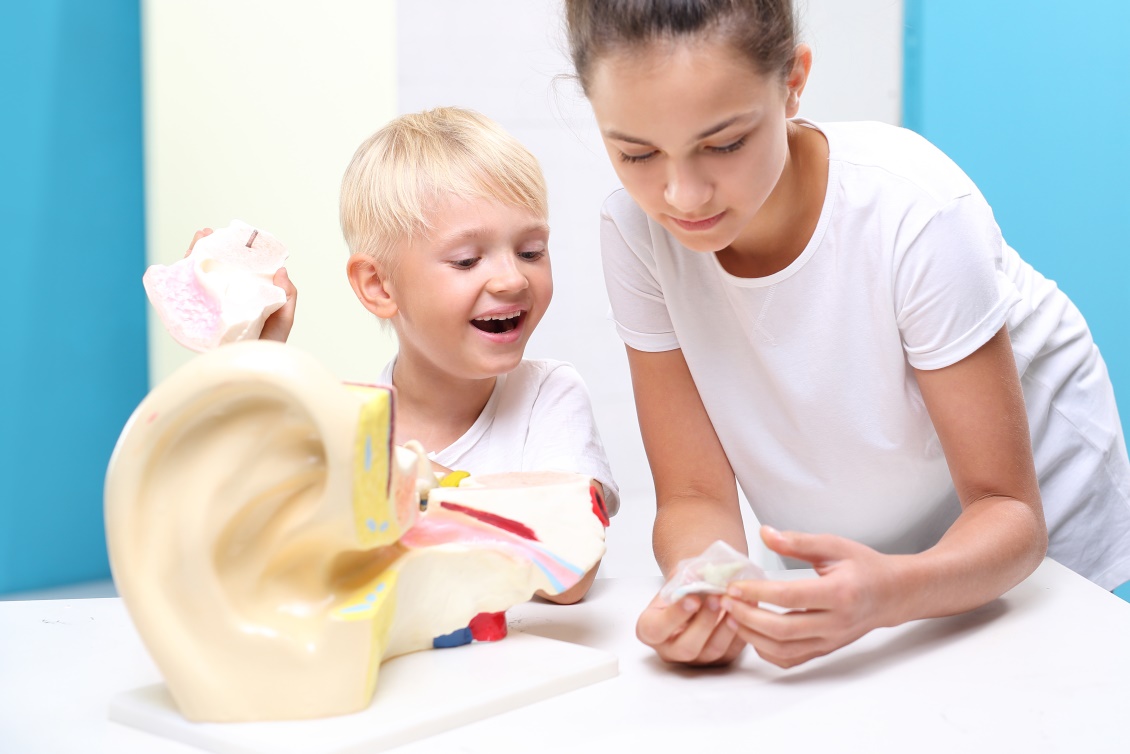
Conditions We Treat
- Adenoids Hypertrophy
- Allergy testing
- Blocked nose
- Chronic cough
- Deafness
- Ear infection in kids
- Ear pain in kids
- Fluid in ear and ear grommets

- Hearing loss
- Hoarseness of voice
- Large Adenoids
- Large tonsils
- Lump on Neck
- Microtia and Ear canal Atresia
- Middle ear infection
- Nose bleeds (epistaxis)
- Removal of Foreign Body
- Runny nose
- Snoring and Sleep Apnea
- Snoring in children
- Throat pain, sore throat
- Tonsil Infection

Most common pediatric ENT cases
1. Tonsillities
Tonsils are two small glands located in the back of throat. Tonsils house white blood cells to help to fight infection. When the tonsils become infected, the condition is called tonsillitis.
Tonsillitis can occur at any age and is a common childhood infection. Tonsillitis Symptoms include a sore throat, swollen tonsils, and fever. This condition is contagious and can be caused by a variety of common viruses or bacteria, such as streptococcal bacteria, which causes strep throat. Tonsillitis caused by strep throat can lead to serious complications if left untreated.

How tonsillitis is diagnosed or what are tonsillitis symptoms?
Diagnosis of acute tonsillitis is based on a physical examination of throat. The doctor may be take a throat culture by gently swabbing the back of throat. The culture will be sent to a laboratory to identify the cause of throat infection.
Tonsillitis treatment (tonsillitis cure)
A mild case of tonsil infection does not necessarily require treatment, especially if it is viral, such as a cold. Pain medicines to relieve the sore throat can help while the throat is healing. Antibiotics will be prescribed to fight a bacterial infection. It’s important to complete the full course of antibiotics. If a person becomes dehydrated due to tonsillitis and swallowing difficulties he may need intravenous fluids.
Home care tips to ease a sore throat pain or tonsillitis remedy at home
When you have throat pain or other throat infection symptoms:
- drink plenty of fluids
- get lots of rest
- gargle with warm salt water several times a day
- use throat lozenges
- use a humidifier to moisten the air in the home
- avoid smoke
Who Needs Tonsillectomy (tonsils surgery or tonsil removal) ?
One case of tonsillitis is not enough to warrant a tonsillectomy. Usually, the surgery is a treatment option for those who are often sick with tonsillitis or strep throat. Tonsillectomy is indicated when there is
- breathing problems related to large tonsils
- recurrent tonsillitis or strep throat
- frequent and loud snoring due to big tonsils
- periods in which breathing stops during sleep, or sleep apnea due to enlarged tonsils
- bleeding of the tonsils
- trouble swallowing chewy foods, especially meats due to big tonslis
- cancer of the tonsils
2. Large Adenoids (Adenoid Hypertrophy)
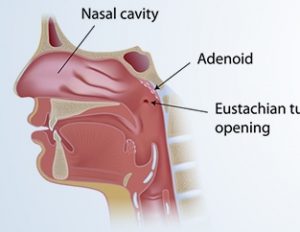
Adenoids in Children are tonsils like lymphoid tissue at the back of the nasal passage. Like tonsils, adenoids help keep the body healthy by fighting harmful bacteria and viruses that you breathe in or swallow. Although you can see the tonsils at the back of the throat, adenoids aren’t directly visible.
Adenoids in kids usually begin to shrink after about 5 years of age and often practically disappear by the teen years.
Adenoids in children while fighting the germs and viruses sometimes become enlarged temporarily and get better, but sometimes adenoids can get infected and enlarged constantly and recurrently affecting on the child’s health. Large adenoids causes nasal blockage and snoring in children and recurrent ear infection in kids, in that case it is recommended to do Adenoid removal. Often, tonsils and adenoids are surgically removed at the same time.
Adenoidectomy ( Adenoid removal or adenotonsillectomy)are indicated when:
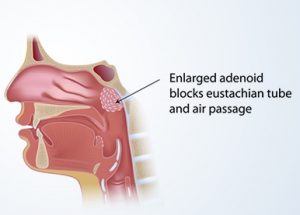
- Kids are snoring because large adenoids
- Noisy breathing and snoring in Children is due to large adenoids
- The breathing stops for a few seconds during sleep (obstructive sleep apnea) due to hypertrophy of adenoid
- Frequent cold or flu symptoms (constant nasal discharge)
- Recurrent Middle Ear infection or persistent fluid the ear or ear pain in kids
3. Fluid in the middle ear or otitis media with effusion or middle ear infection
 Fluid in ear, also called otitis media with effusion (OME) or middle ear infection with effusion, is a condition in which fluid builds up behind the eardrum in the middle ear without symptoms of an ear infection. It is a common condition. Nearly all children get ear fluid in ear at least once by school age
Fluid in ear, also called otitis media with effusion (OME) or middle ear infection with effusion, is a condition in which fluid builds up behind the eardrum in the middle ear without symptoms of an ear infection. It is a common condition. Nearly all children get ear fluid in ear at least once by school age
Why fluid in ear or ear infection is common in children?
Middle ear is close cavity which needs to be full of air and it is connected with the back of the throat by The Eustachian tube. When the tube opens it allows air to move into the middle ear.
Children often develop colds and if the Eustachian tubes become infected, the walls may stick together so the air in the middle ear cannot circulate. Mucus may then be produced, which can fill the middle ear cavity.
How might fluid in ear affect my child?
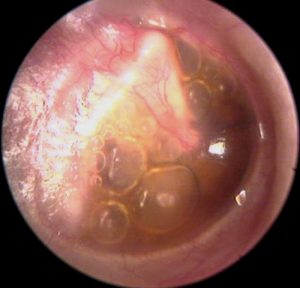 The most common problem are mild discomfort, fullness in the ear and mild hearing loss which last only a few weeks and gets better by itself but sometimes it might go on for many months causing more hearing loss and ear pain in kids.
The most common problem are mild discomfort, fullness in the ear and mild hearing loss which last only a few weeks and gets better by itself but sometimes it might go on for many months causing more hearing loss and ear pain in kids.
If a young child’s hearing is impaired by fluid in the middle ear, this may delay their language and speech development and may also contribute to behavior problems – such as lack of concentration or attention.
How fluid in ear is diagnosed?
The doctor will examine the ears by Otoscope to find if there is fluid in ear or air fluid level behind the drums. Tympanogram (especial hearing test to measure middle ear pressure) will be done; B type or flat tracing will confirm presence of fluid in ear behind the drum. Age appropriate hearing tests will be done for hearing level estimation
Should I worry if my child has fluid in ear?
Most fluid goes away on its own in weeks or months .Ear fluid concerns if it lasts > 3mo or when your child has other problems which could be made worse by persistent fluid in ear (delay in speech, language, learning or developmental problems)
What can I do at home to help the middle ear infection or recurrect ear infections to go?
Keep your child away from second hand smoke, especially in closed spaces. Such as the car or inside the house .If your child is more than one year and still uses pacifier, stop it
 Can my child travel by airplane if fluid in ear is present?
Can my child travel by airplane if fluid in ear is present?
If the ear is completely full of fluid, there is usually no problem but when the fluid is partial or mixed with air. It can hurt when the plane is coming down. Tympanogram will give flat reading when the ear is completely full of fluid ,visit your doctor to determine that .It may help to keep your child awake when the plane is landing and to encourage him or her to swallow.
Treatments and procedures
Tonsillectomy (tonsils surgery or tonsils removal)
Tonsillectomy or tonsils surgery is a surgical procedure to remove the tonsils. There are several different ways for tonsils removal. No matter what surgical method doctor chooses, it is done under general anesthetic and takes 45-minutes to 1 hour. The patient won’t be aware of the surgery or won’t feel any pain. When he wakes up after the tonsil surgery, he’ll be in a recovery room. Medical staff will be monitoring his blood pressure and heart. He will usually need to stay in hospital for only one night.
Adenoidectomy/ Adenotonsillectomy/ Adenoids removal surgery
Adenoidectomy is a surgical procedure for removing the adenoids can be done alone or with tonsillectomy as per the doctor decision. They are removed through the mouth. It is performed under General Anesthesia .Your Child will be in the operating theatre for between 45 minutes to one hour.
Post-Operative Instructions: Adenotonsillectomy, Tonsillectomy, Adenoidectomy
- 2-3 days after a tonsillectomy you will note an increase in pain in the throat. This is the inflammation settling and the scabs starting to form. The scabs will be white, yellow or green coating where tonsils once were. This is not a sign of infection. Foul breath is normal while scabs are present. The scabbing color can change throughout recovery. It is not normal to have coating on the tongue.
- 2-3 days after an adenoidectomy you may have increase in nasal congestion. This is caused by the inflammation settling in and is normal recovery .You may have some blood tinged mucus from the nose . This should not be like a nosebleed, and should only appear in small amounts mixed in with the mucus. A sore or stiff neck is also common after an Adenoidectomy
- Approximately one week after a tonsillectomy you will have a major increase in throat pain. At this point the scabs are starting to come off. A little bit of bleeding or oozing is okay at this point. If these are noted you can drink cold items .If bleeding persists proceed to ER immediately
- Ear Pain is very normal after a tonsillectomy and can be present throughout the whole recovery process
- No lifting, bending, straining for two weeks following the surgery. do not travel for two weeks following surgery .or until seen post operatively
- Staying hydrated after Tonsillectomy is very important. Even if the patient isn’t eating much at all .as long as they are hydrated this is okay. Signs of dehydration are uncontrollable pain, high temperature headache and nausea and vomiting and lethargic behavior .If you suspect dehydration go to ER at once for IV Fluid replacement.
- Diet after a Tonsillectomy: Soft foods are recommended. Avoid acid items as they may burn when swallowing. Popsicles, gelatin juices not acidic, water, soft drinks are good. Avoid milk/dairy products for at least a few days following surgery as they may increase phlegm production. Salty foods such as soups, broths may help relieve discomfort and promote healing
Tympanostomy and Grommet insertion
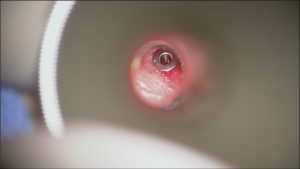
Placing a tiny tube in the eardrum to reduce building fluid in ear that causes hearing loss and as a recurrent ear infection treatment.
The operation takes about 10-20 min and usually requires general anesthesia
How long is recovery from tympanostomy and grommet insertion?
The surgery is relatively painless and most children are back to their normal selves within a couple of hours after waking from anesthesia. They will be not aware of the presence of the grommet.
There may be some discharge from the ears which usually settles within a few days. Antibiotic drops are often prescribed to use for a few days to stop any discharge
What are the benefits of tympanostomy and grommet insertion?
Relieves fluid and hearing loss promptly and prevents relapse of fluid while the tube is in place and stays open and prevents recurrent middle ear infection.
What are the potential risks and side effects of tympanostomy and grommet insertion?
About 1 in 4 children get an ear infection (ear discharge) that is treated with eardrops. About 2 or 3 in 100 children have a tiny hole in the eardrum that doesn’t close after the tubes fall out and may need surgery. There is very small risk of serious problems from the anesthesia.
What usually happens in the long term after tympanostomy and grommet insertion?
Most grommets fall out in about 12 to 18 months .About 1 in every 4 children may need to have groomets again after falling down
Is there any special precautions after grommet insertion?
Baths and air travel are fine. Some children need earplugs if water bothers their ears when diving and swimming

